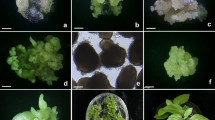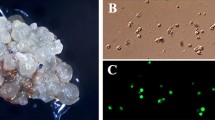Summary
Digitaria sanguinalis (crabgrass) has recently been introduced as a high quality forage crop. We report here a tissue culture system showing a high level of regeneration developed to aid in a breeding program. Two morphologically distinct types of callus, compact opaque and friable translucent, were induced from leaf blade explants and mature seeds when cultured on MS medium containing 0.9 μM 2,4-dichlorophenoxyacetic acid. Proline (25 mM) inhibited induction of callus but was required for continued maintenance. Plants were readily regenerated from the compact opaque callus. Selectively subcultured friable translucent callus continued to produce colony sectors of the morphogenically competent compact opaque callus when transferred to regeneration medium. Suspension cell cultures derived from callus or directly from leaf blade explants also produced regenerable callus.
Similar content being viewed by others
References
Ahloowalia, B. S. Forage grasses. In: Ammirato, P. V.; Evans, D. A.; Sharp, W. R., et al. Handbook of plant cell culture, vol. 3. New York: Macmillan; 1984:91–125.
Dalrymple, R. L. A summary of research and demonstration about the use of crabgrass as a forage. Noble Foundation publication no. CB-83 Ardmore. OK: SRNF; 1983.
Dalrymple, R. L.; Rogers, J.; Huneycutt, H. et al. Crabgrass selection forage yields. Noble Foundation publication no. CG-84 Ardmore. OK: SRNF, 1984.
Duncan, D. R.; Williams, M. E.; Zehr, B. E., et al. The production of callus capable of plant regeneration from immature embryos of numerousZea mays genotypes. Planta 165:322–332; 1985.
Fladung, M.; Hesselbach, J. Callus induction and plant regeneration inPanicum bisulcatum andPanicum milioides. Plant Cell Rep. 5:169–173; 1986.
Hanning, G. E.; Conger, B. V. Embryoid and plantlet formation from leaf segments ofDactylis glomerata L. Theor. Appl. Genet. 63:155–159; 1982.
Haydu, Z.; Vasil, I. K. Somatic embryogenesis and plant regeneration from leaf tissues and anthers ofPennisetum purpureum Schum. Theor. Appl. Genet. 59:269–273; 1981.
Kasperbauer, M. J.; Buckner, R. C.; Bush, L. P. Tissue culture of annual ryegrass x tall fescue F1 hybrids: callus establishment and plant regeneration. Crop Sci. 19:457–560; 1979.
Linacero, R.; Vazquez, A. M. Somatic embryogenesis and plant regeneration from leaf tissues of rye (Secale cereale L.) Plant Sci. 44:219–222; 1986.
Lu, C.; Vasal, I. K. Somatic embryogenesis and plant regeneration from leaf tissue ofPanicum maximum. Theor. Appl. Genet. 59:275–280; 1981.
Murashige, T.; Skoog, F. A. A reviewed medium for rapid growth and bioassays with tobacco tissue cultures. Physiol. Plant 15:437–498; 1962.
Ranch, J. P.; Oglesby, L.; Zielinski, A. C. Plant regeneration from embryo-derived tissue cultures of soybeans. In Vitro 21:653–658; 1985.
Wu, L.; Antonovics, J. Zinc and copper tolerance ofAgrostis stolonifera in tissue culture. Am. J. Bot. 65:268–271; 1978.
Author information
Authors and Affiliations
Rights and permissions
About this article
Cite this article
Gonzales, R.A., Franks, E. Induction of morphogenically competent callus and suspension cell cultures from leaf explants and mature seeds ofDigitaria sanguinalis . In Vitro Cell Dev Biol 23, 581–584 (1987). https://doi.org/10.1007/BF02620976
Received:
Accepted:
Issue Date:
DOI: https://doi.org/10.1007/BF02620976




